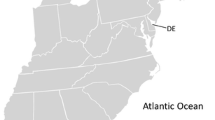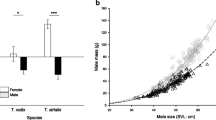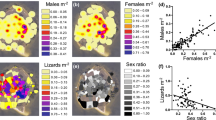Abstract
Comparative analyses have found that relative testis size is a strong predictor of the prevalence of sperm competition for many taxa, including mammals, yet underlying this pattern is the assumption that intraspecific variation in testis size is related to individual fitness. Because intraspecific variation in ejaculate investment underlies interspecific patterns, it is critical to understand the causes and consequences of intraspecific variation in ejaculate investment. We examined relationships between ejaculate investment (testis size and sperm length) and reproductive success, body size and condition in the yellow-pine chipmunk (Tamias amoenus), a small ground squirrel in which sperm competition occurs. We examined genetic estimates of male reproductive success from a wild population of yellow-pine chipmunks and determined that males with large testes had higher annual reproductive success than males with small testes. This result provides empirical support for the numerous comparative studies that indicate testis size is associated with the intensity of sperm competition. In addition, males in good condition had relatively larger testes than males in poor condition, but there was no evidence of sperm length being dependent on condition. Finally, contrary to many predictions, males that invested more in sperm production (relatively heavy testes) produced shorter sperm, not longer sperm, than males that invested less.



Similar content being viewed by others
References
Andersson M (1994) Sexual selection. Princeton University Press, Princeton, NJ
Balshine S, Leach BJ, Neat F, Werner NY, Montgomerie R (2001) Sperm size of African cichlids in relation to sperm competition. Behav Ecol 12:726–731
Bercovitch FB, Nürnberg P (1996) Socioendocrine and morphological correlates of paternity in rhesus macaques (Macaca mulatta). J Reprod Fertil 107:59–68
Birkhead TR, Møller AP (1998) Sperm competition and sexual selection. Academic Press, San Diego
Birkhead TR, Parker GA (1997) Sperm competition and mating systems. In: Krebs JR, Davies NB (eds) Behavioural ecology: an evolutionary approach. Blackwell, Oxford, pp 121–145
Briskie JV, Montgomerie R, Birkhead TR (1997) The evolution of sperm size in birds. Evolution 51:937–945
Byrne PG, Roberts JD, Simmons LW (2002) Sperm competition selects for increased testes mass in Australian frogs. J Evol Biol 15:347–355
Callahan JR (1981) Vocal solicitation and parental investment in female Eutamias. Am Nat 118:872–875
Concannon P, Roberts P, Parks J, Bellezza C, Tennant B (1996) Collection of seasonally spermatozoa-rich semen by electroejaculation of laboratory woodchucks (Marmota monax), with and without removal of buolbourethral glands. Lab Anim Sci 46:667–675
Elliott L (1978) Social behaviour and foraging ecology of the eastern chipmunk (Tamias striatus) in the Adirondack mountains. Smithson Contrib Zool 265:1–107
Gage MJG (1994) Associations between body size, mating pattern, testis size and sperm lengths across butterflies. Proc R Soc Lond B Biol Sci 261:25–30
Gage MJG, Cook PA (1994) Sperm size or numbers? Effects of nutritional stress upon eupyrene and apyrene sperm production strategies in the moth Plodia interpunctella (Lepidoptera: Pyralidae). Funct Ecol 8:594–599
Gage MJG, Freckleton RP (2003) Relative testis size and sperm morphometry across mammals: no evidence for an association between sperm competition and sperm length. Proc R Soc Lond B Biol Sci 270:625–632
Gage MJG, Stockley P, Parker GA (1995) Effects of alternative male mating strategies on characteristics of sperm production in the Atlantic salmon (Salmo salar): theoretical and empirical investigations. Philos Trans R Soc Lond B 350:391–399
Ginsburg JR, Huck UW (1989) Sperm competition in mammals. Trends Ecol Evol 4:74–79
Ginsburg JR, Rubenstein DI (1990) Sperm competition and variation in zebra mating behaviour. Behav Ecol Sociobiol 26:427–434
Gomendio M, Roldan ERS (1991) Sperm competition influences sperm size in mammals. Proc R Soc Lond B Biol Sci 243:181–185
Gomendio M, Harcourt AH, Roldan ERS (1998) Sperm competition in mammals. In: Birkhead TR, Møller AP (eds) Sperm competition and sexual selection. Academic Press, San Diego, pp 667–751
Harcourt AH, Harvey PH, Larson SG, Short RV (1981) Testis weight, body weight, and breeding system in primates. Nature 293:55–57
Heske EJ, Ostfeld RS (1990) Sexual dimorphism in size, relative size of testes, and mating systems in North American voles. J Mammal 71:510–519
Hosken DJ (1997) Sperm competition in bats. Proc R Soc Lond B Biol Sci 264:385–392
Kenagy GJ, Trombulak SC (1986) Size and function of mammalian testes in relation to body size. J Mammal 67:1–22
Koprowski JL (1993) Alternative reproductive tactics in male eastern gray squirrels: “making the best of a bad job”. Behav Ecol 4:165–171
Leach B, Montgomerie R (2000) Sperm characteristics associated with different male reproductive tactics in bluegills (Lepomis macrochirus). Behav Ecol Sociobiol 49:31–37
Martin ICA (1978) The principles and practice of electroejaculation of mammals. Symp Zool Soc Lond 43:127–152
Merilä J, Kruuk L, Sheldon, BC (2001) Natural selection on genetical component of variation in body condition index in a wild bird population. J Evol Biol 14:918–929
Møller AP (1991) Sperm competition, sperm depletion, paternal care, and relative testis size in birds. Am Nat 137:882–906
Møller AP, Birkhead TR (1989) Copulation behaviour in mammals: evidence for widespread sperm competition. Biol J Linn Soc 38:119–131
Møller AP, Briskie JV (1995) Extra-pair paternity, sperm competition and the evolution of testis size in birds. Behav Ecol Sociobiol 36:357–365
Parker GA (1990a) Sperm competition games: raffles and roles. Proc R Soc Lond B Biol Sci 242:120–126
Parker GA (1990b) Sperm competition games: sneaks and extra-pair copulations. Proc R Soc Lond B Biol Sci 253:127–133
Parker GA (1993) Sperm competition games: sperm size and sperm number under adult control. Proc R Soc Lond B Biol Sci 253:245–254
Parker GA (1998) Sperm competition and the evolution of ejaculates: towards a theory base. In: Birkhead TR, Møller AP (eds) Sperm competition and sexual selection. Academic Press, San Diego, pp 3–54
Parker GA, Begon M (1993) Sperm competition games: sperm size and number under gametic control. Proc R Soc Lond B Biol Sci 264:1793–1802
Pitnick S, Markow T, Spicer GS (1999) Evolution of multiple kinds of female sperm-storage organs in Drosophila. Evolution 53:1804–1822
Preston BT, Stevenson IR, Pemberton JM, Coltman DW, Wilson K (2003) Overt and covert competition in a promiscuous mammal: the importance of weaponry and testes size to male reproductive success. Proc R Soc Lond B Biol Sci 270:633–640
Ribble DO, Millar JS (1992) Intraspecific variation in testes size among northern populations of Peromyscus. Funct Ecol 6:455–459
Rising JD (1987) Geographic variation in testis size in savannah sparrows (Passerculus sandwichensis). Wilson Bull 99:63–72
Schulte-Hostedde AI, Millar JS (2000) Measuring sexual size dimorphism in the yellow-pine chipmunk (Tamias amoenus). Can J Zool 78:728–733
Schulte-Hostedde AI, Millar JS (2002) “Little chipmunk” syndrome?: Male body size and dominance in captive yellow-pine chipmunks (Tamias amoenus). Ethology 108:127–137
Schulte-Hostedde AI, Gibbs HL, Millar JS (2000) Microsatellite DNA loci suitable for parentage analysis in the yellow-pine chipmunk (Tamias amoenus). Mol Ecol 9:2180–2181
Schulte-Hostedde AI, Millar JS, Hickling GJ (2001) Evaluating body condition in small mammals. Can J Zool 79:1021–1029
Schulte-Hostedde AI, Millar JS, Gibbs HL (2002) Female-biased sexual size dimorphism in the yellow-pine chipmunk (Tamias amoenus): sex-specific patterns of annual reproductive success and survival. Evolution 56:2519–2529
Schulte-Hostedde AI, Millar JS, Gibbs HL (2003) Sexual selection and mating patterns in a mammal with female-biased sexual size dimorphism. Behav Ecol (in press)
Sheppard DH (1969) A comparison of reproduction in two chipmunk species (Eutamias). Can J Zool 47:603–608
Simmons LW, Kotiaho JS (2002) Evolution of ejaculates: patterns of phenotypic and genotypic variation and condition dependence in sperm competition traits. Evolution 56:1622–1631
Stockley P, Purvis A (1993) Sperm competition in mammals: a comparative study of male roles and relative investment in sperm production. Funct Ecol 7:560–570
Stockley P, Gage MCG, Parker GA, Møller AP (1997) Sperm competition in fishes: the evolution of testis size and ejaculate characteristics. Am Nat 149:933–954
Vladic TV, Jarvi T (2001) Sperm quality in the alternative reproductive tactics of salmon: the importance of the loaded raffle mechanism. Proc R Soc Lond B Biol Sci 268:2375–2381
Ward PI (1998) Intraspecific variation in sperm size characters. Heredity 80:655–659
Wauters LA, Dhondt AA, De Vos R (1990) Factors affecting male mating success in red squirrels (Sciurus vulgaris). Ethol Ecol Evol 2:195–204
Yahner RH (1978) The adaptive nature of the social system and behaviour in the eastern chipmunk, Tamias striatus. Behav Ecol Sociobiol 3:397–427
Yasui Y (1997) A “good-sperm” model can explain the evolution of multiple mating by females. Am Nat 149:573–584
Acknowledgements
We thank Dr. K. Goodrowe and D. Ryckman of the Toronto Zoo, and Prof. C. Platz of the International Canine Semen Bank for advice on the electroejaculation technique, and Dr. R. Cooper of the Calgary Zoo for the loan of the electroejaculation equipment. Dr. R.D. Montgomerie provided facilities for the measurement of sperm morphology. The University of Calgary’s Kananaskis Field Station is gratefully acknowledged for logistical assistance. We are indebted to H.L. Gibbs and L. DeSousa for facilities and expertises in the genetic analysis of male reproductive success. Comments from G. Burness, S. Casselman and two anonymous reviewers greatly improved the manuscript. This study was supported by an Ontario Graduate Scholarship, Natural Sciences and Engineering Research Council of Canada (NSERC) post-graduate scholarship and two grants-in-aid of research from the American Society of Mammalogists to A.I.S.-H., and an NSERC operating grant to J.S.M. All procedures described herein were approved by the Canada Council on Animal Care.
Author information
Authors and Affiliations
Corresponding author
Additional information
Communicated by P.M. Kappeler
Rights and permissions
About this article
Cite this article
Schulte-Hostedde, A.I., Millar, J.S. Intraspecific variation of testis size and sperm length in the yellow-pine chipmunk (Tamias amoenus): implications for sperm competition and reproductive success. Behav Ecol Sociobiol 55, 272–277 (2004). https://doi.org/10.1007/s00265-003-0707-z
Received:
Revised:
Accepted:
Published:
Issue Date:
DOI: https://doi.org/10.1007/s00265-003-0707-z




